“My belief was that if you can afford it, buy it," says Modi, who’s dressed in a blue kurta pyjama at his house in Newtown, Kolkata. His then-four-year-old business, Vedant Fashions, which made popular ethnic wear, Manyavar, was doing reasonably well and money was flowing smoothly. However, as he firmed up his plans to buy a Mercedes, his father, who had earlier inadvertently brought out the entrepreneur in Modi, asked his son a few questions. And then doled out some sound advice.
That stuck with him forever. Modi skipped his plan to buy a Mercedes, and instead decided to plough back all the profits into the business to avoid falling into a debt trap as he expanded. He stuck with his Honda City for the next 15 years, until his son asked him to change it after a family friend met with an accident. “That’s when I bought my Mercedes in 2017," Modi says. “All these things don’t matter to me. I am a simple man with no materialistic needs. I like the simple life."
Modi indeed leads a simple life on the outskirts of Kolkata. Unlike many of his peers who relish the hustle and bustle of city life, he has moved out of his home of 36 years to a calm and greener township where he even grows vegetables. “Whatever vegetables we eat, they come from within the house," Modi says. He prefers to meet people on the verandah of his house, which overlooks a neatly manicured lawn. The scorching Kolkata heat doesn’t bother him.
“Here, the trees talk to me," says Modi, who tried 12 houses before shifting to the new one immediately after the first lockdown. He has built a clay tennis court there and is now learning to play the game. Modi has also renounced wearing western clothes, claiming not to have worn one in five years. “We must realise that clothes such as suits aren’t meant for the Indian climate," he says.
He’s even reduced the time he spends in office, and now goes there only once a week. It hasn’t made any difference to his business. Modi makes his debut on the 2022 Forbes World’s Billionaires List—he’s ranked 1,238 with a net worth of $2.5 billion. As of April 15, Modi’s wealth stood at $3 billion and he is among the youngest billionaires in India.
`![]()
His 23-year-old company, Vedant Fashions Limited, of which he is chairman and managing director, is worth ₹26,000 crore after it listed on the bourses in February. It has over 600 stores across India and 11 international stores, where it sells everything from men’s kurtas, sherwanis and jackets to women’s lehengas, sarees and gowns. They are sold under brands such as Manyavar, Mohey and Mebaz.
Last year, amid the pandemic, Vedant Fashions closed the year with a revenue of ₹564.81 crore, while net profit stood at ₹132.9 crore. A year before that, revenue was ₹915.54 crore and net profit ₹236.6 crore. Modi’s wife Shilpi has a board seat, while his only child, Vedant, after whom the company is named, is chief marketing officer.
“I am a firm believer in destiny," says Modi. If it wasn’t for his destiny, the 45-year-old believes he would have perhaps been sitting at his nearly-50-year-old family-run shop in Kolkata’s AC Market, selling menswear, and at best opened one more store to expand the business.
![]() Modi with his wife Shilpi (seated) and son Vedant (right)
Modi with his wife Shilpi (seated) and son Vedant (right)
Destined for Success
As a child, Modi, the only son of his parents, was good at mathematics. His father then ran a 140-sq-ft retail store inside AC Market in Kolkata—one of India’s first air-conditioned markets set up some 50 years ago.
“In Class 2, I got 100 in mathematics, and my mother threw a party," says Modi. “In Class 3, when I got 100, my mother didn’t give a party. That’s when I realised that nobody celebrates the same achievement twice. I needed some kick and I started solving the paper faster." By the time he appeared for his Class 12 exam, he finished his mathematics papers in 45 minutes, scoring a near cent. “Anybody who remembers me from school days would remember me for mathematics," says the soft-spoken billionaire.
![]() That meant, by the time he was 13, Modi joined his father at their retail store, which sold everything from shirts and pants to jeans, after school. “I found a lot of interest," says Modi. “Somehow, I didn’t realise that my entire childhood from 13 years went in my store." While he did contemplate doing an MBA after graduating in commerce from St Xavier’s college, Kolkata, his father suggested otherwise. “The real MBA happened in those nine years between 13 and 22," says Modi.
That meant, by the time he was 13, Modi joined his father at their retail store, which sold everything from shirts and pants to jeans, after school. “I found a lot of interest," says Modi. “Somehow, I didn’t realise that my entire childhood from 13 years went in my store." While he did contemplate doing an MBA after graduating in commerce from St Xavier’s college, Kolkata, his father suggested otherwise. “The real MBA happened in those nine years between 13 and 22," says Modi.
At the store, Modi played salesman, often catering to buyers his staff didn’t want to deal with. “I would see that the salesmen would deal with some customers with a lot of attention, and some without," says Modi. “When I probed them, they said the customers wouldn’t buy. I would ask them if they were astrologers, and used to take it on me to sell stuff to them. That was my kick." Soon, Modi would end up selling over 20 clothes to a customer who would have come to buy one shirt. “It was the best time of my life," Modi says. By the time he was 21, he was married, and by 22, Modi became a father.
As the business grew, Modi began to run the show and took decisions that would be a contrast to his father’s. He also introduced Indian wear, manufactured by them, in the store after realising a massive vacuum in the Indian wear category. It was Modi’s first tryst with manufacturing. “But one day, my father said something, and I got hurt," Modi says. His father had questioned a decision that Modi had taken for ₹20,000. “He said ‘Humko barbad kardoge (Will you ruin us)? I might commit suicide one day.’ I said this is enough, I won’t come from tomorrow."
He took ₹10,000 from his mother and turned to manufacturing Indian wear, selling the finished products in Uttar Pradesh, Odisha, Bihar, Madhya Pradesh and West Bengal, among others. “I started selling to multi-brand outlets (MBOs)," he says. The inability to hire a creative agency meant Modi had to come up with a name. “I thought what was the purpose of life… it was to earn some respect for oneself," says Modi. “That’s how we came up with the name Manyavar." He denies that the choice of the name had anything to with his father’s chiding. “He was someone who would never say something like that," says Modi. “It’s all destiny. Because there was no plan, and I was happy at the store. We would, at best, have opened one more store."
With Manyavar, Modi started by selling 20 percent of his stock to Kolkata-based Vishal Mega Mart, to raise enough working capital to sustain his business. He sold the rest of the stock to other outlets. “Vishal Maga Mart was the only place that used to buy on cash," says Modi. “So initially, for about eight months, the working capital came from them."
Modi sold kurtas which cost ₹200 at a loss of ₹10 to ensure he was paid in cash. “Just because I was strong in math, I thought I will sell 20 percent of my production to him to get working capital, and from the remaining 80 percent production, I will get revenue. That is how we generated revenue in the first year," Modi says.
Among others, Manyavar’s clothes were sold at outlets such as the Kashmir Vastralaya collection and Kala Mandir in the early days.
Turning point
By 2005-06, Modi had begun selling his products to large format stores (LFS)—from Future Group to Shoppers Stop and Westside—building a pan-India presence. Heeding his father’s advice, he ensured he did not take on debt, and instead channelled most of the money into the business.
![]() In 2006, to take care of his ailing father, Modi stepped away from work for some six months. “I used to work like a typical entrepreneur, managing everything. Life was very busy. Then I realised we were unnecessarily involving ourselves in operations. The business was running well without me for six months. From that day I understood, that instead of ROI (return on investment), it should be return on time invested (ROTI). I realised I should not waste time on things where I don’t add any value," he says.
In 2006, to take care of his ailing father, Modi stepped away from work for some six months. “I used to work like a typical entrepreneur, managing everything. Life was very busy. Then I realised we were unnecessarily involving ourselves in operations. The business was running well without me for six months. From that day I understood, that instead of ROI (return on investment), it should be return on time invested (ROTI). I realised I should not waste time on things where I don’t add any value," he says.
That took him back to the drawing board—to focus on strategy for the next phase of growth. By 2008, Manyavar set up its first exclusive brand outlet (EBO). “That’s when the real journey began," says Modi. “Until then, we used to sell for ₹20-25 crore every year." The company’s first store opened in Bhubaneswar, and over the next year, opened 12 stores. The early ones were opened by the company before it moved to a franchise-led model. “By that time, I was clear that the way forward for any fashion apparel business in India is EBO," says Modi.
Modi believed multi-brand outlets were becoming more of a hindrance than being facilitators. “They never used to work on data," he says. “It was difficult to make them understand anything. And because I had spent nine years with consumers, we used to always think of the customers first."
That means an obsession with data, and efficiency, something Modi spends a considerable amount of time on. “Anything and everything we do, we want to bring efficiency," he says. “We have one of the highest productivities in retail. We haven’t sold a single garment at discount. Even then, the dead stock in Manyavar is less than 3 percent. We make 30 percent PAT (profit after tax). We don’t make that by charging more to the consumer. That’s an outcome of efficiency. We keep pricing reasonable and despite that, we have the highest margin. Efficiency is a key pillar in our entire organisation."
Today, the company operates mostly on a franchise-owned-franchise-operated model. “When we started, we had a COCO (company-owned-company-operated), COFO (company-owned-franchise operated), FOFO (franchise-owned-franchise-operated), and all kinds of models. By 2016-17, we converted all our stores into the FOFO model. People were doing backward integration, and we felt doing forward integration was the way to go. We will do the marketing, designing and supply chain, and not do anything else." Over the past few years, Modi claims several young customers have become franchise owners, including doctors and consultants, who see massive potential in the brand.
![]()
In 2016, the company pulled a coup of sorts by landing then Indian cricket captain Virat Kohli as brand ambassador. “He had just become captain It was the best time of his life," says Modi. Over the next few years, Kohli led the brand campaign and Modi even roped in his girlfriend Anushka Sharma for a commercial prior to their marriage. Today, the brand has actors Amitabh Bachchan, Alia Bhatt, Ranveer Singh and Kartik Aaryan as brand ambassadors.
“Manyavar has been able to build up a market for itself in the past 10 years, and the business has grown steadily and rapidly," says Harminder Sahni, founder and managing director of Gurugram-based management consultancy Wazir Advisors. “While most Indian companies were looking at western wear, Modi moved into the category, while others missed the bus. That has helped it create a strong impact with Indian customers. Now it is also able to capture the women’s wedding wear market as a result."
The success
Today, Manyavar operates some 1.3 million sq ft of retail stores in the country, choosing not to chase the number of stores. Every year, Modi wants to add between 1.5 lakh sq ft and 2 lakh sq ft of retail space. “The whole business is on a variable, asset-light model," he says. “There is no capex, there is no fixed expense other than corporate head office salary. Every rupee of working capital can generate an equal rupee of PAT, with 90-95 percent free cash flow. Only Unilever will have a ROCE (return on capital employed) of 100 percent, and we might be the second, and within a year or two, we will be at more than 100 percent."
![]() The company operates in 230 cities, and is busy firming up plans to open stores in 150 new cities. A significant portion of its customers are spread across Southern India, with Bengaluru and Hyderabad emerging as the two big centres. “We have a cluster approach where we believe in 50 or 60 markets, where we have numerous stores," Modi says. “This is just the beginning of a multi-decade growth opportunity for the category."
The company operates in 230 cities, and is busy firming up plans to open stores in 150 new cities. A significant portion of its customers are spread across Southern India, with Bengaluru and Hyderabad emerging as the two big centres. “We have a cluster approach where we believe in 50 or 60 markets, where we have numerous stores," Modi says. “This is just the beginning of a multi-decade growth opportunity for the category."
Along the way, in 2017, as business expanded rapidly, Modi decided to turn to private equity, not because he needed money for expanding the business. “We always thought that there is a limit for wisdom and knowledge," says Modi. “We had been meeting private equity players since 2008 and we thought why not get a good partner. We liked Kedaara Capital and its approach. Money was not the intent, but to have a wise board and to understand whether we were missing on anything." Kedaara Capital acquired 7.5 percent stake in the company.
“They’ve ridden well on the sector’s growth and consolidation into modern trade, as the desire for brands has grown among buyers of Indian traditional clothing," says Devangshu Dutta, chief executive of Third Eyesight, a management consulting firm, and managing partner of PVC Partners, an early-stage investment & advisory firm. “Also, the wedding market is more recession-proof than many other segments, which has been a favourable factor during the pandemic."
Last year, despite the pandemic, Modi says Vedant Fashions closed the year with better profit margins, despite most states putting a ban on weddings and other social gatherings. “The beauty of our business is that while business had reduced, our margins were 30 percent PAT," Modi says. “The entire business is on the variable model and even franchises didn’t lose money."
In India, the men’s wedding and celebration wear market was estimated to be worth approximately ₹13,300 crore as of FY20, according to brokerage firm HDFC Securities. It is projected to increase to between ₹17,000 crore and ₹18,000 crore by 2025. In comparison, the women’s wedding and celebration wear market is significantly larger, estimated to be worth approximately ₹7,500 crore as of 2020. It is expected to grow to ₹95,000 crore and ₹100,000 crore by 2025.
“Seventy-three percent of Vedant Fashions Limited’s (VFL) franchisees have operated its stores for three or more years and 65 percent of the sales of its customers from its franchisee-owned EBOs are derived from franchisees having two or more stores is testament to the success of EBO distribution model," HDFC Securities said in a report in February. “Through a network of over 300 franchisees as of September 2021, VFL has demonstrated a track record of commanding a high initial capital commitment and, in return, providing all necessary support in connection with identifying potential locations for new stores, managing multi-channel advertising on a national and regional basis, assisting in-store development and inventory management, directly managing the supply chain and providing detailed training programmes for store staff and franchisees."
![]() Today, 90 percent of the company’s business comes from EBO with about 8 percent from online models, a segment that Modi’s son, Vedant, and his team are extensively looking to build. “We might be the only brand with such a high percentage from EBOs," Modi says. “The segment is unorganised, fragmented, and understanding this is a journey. Because we were data-focussed, we could work it out." Along the way, Modi says his biggest advantage has been in reducing the inconvenience of wedding purchases.
Today, 90 percent of the company’s business comes from EBO with about 8 percent from online models, a segment that Modi’s son, Vedant, and his team are extensively looking to build. “We might be the only brand with such a high percentage from EBOs," Modi says. “The segment is unorganised, fragmented, and understanding this is a journey. Because we were data-focussed, we could work it out." Along the way, Modi says his biggest advantage has been in reducing the inconvenience of wedding purchases.
“Pre-Manyavar, the wedding shopping experience was a problem," Modi says. “You had to go a few times to the store for measurements or alterations. Now people don’t have the time. We are a one-stop solution where work can be done in one hour."
Now, as the company looks at avenues for its next phase of growth, Modi has forayed into categories within the wedding market that can drive sales. The company recently launched Twamev, a premium collection of men’s wedding wear, and Manthan, a cheaper option to its popular Manyavar wear. “When you look at the Indian pyramid, there are five consumer layers. Manyavar and Mohey are in the third layer which is the sweet spot, comprising the typical aspirational middle class," Modi says. “In India, one crore weddings take place, and 30 lakh to 35 lakh marriages happen in that category, which is about 50 percent in terms of value. We believe that is the largest segment, but now we have a strategy where we are going one level up and down."
While Manyavar caters to the ₹5 lakh to ₹50 lakh wedding market, the ₹50 lakh to ₹5crore market is being catered to by Twamev, while the less than ₹5 lakh is being addressed by the Manthan range. “We believe once the category grows, we should be there in all these three layers. So, there is clear demarcation and no overlap," Modi says.
All that means that the reclusive billionaire, who started out two decades ago after his tryst with destiny, is getting ready for a long period of growth. It also helps that he has more time to plot his strategy for it. “People talk about wealth, I believe the real wealth I have earned is time for myself," Modi says. “The mission is to be a dominant player in the celebration space. We have cracked an unorganised market and we’ve been able to organise it and scale it. Now, the vision is to instill pride in Indian wear."
Modi seems determined to do that. And he is certain to walk that talk, if the two decades are anything to go by.


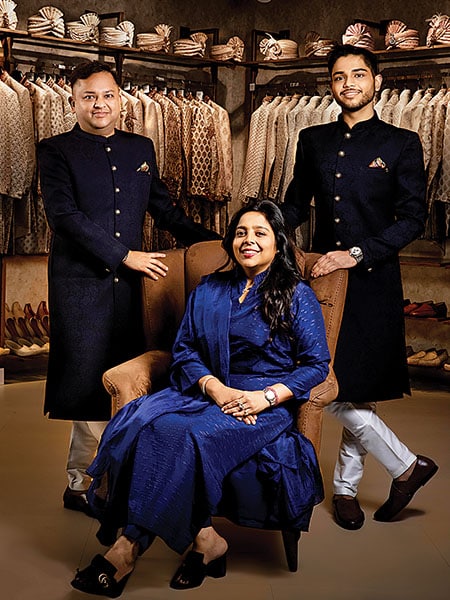
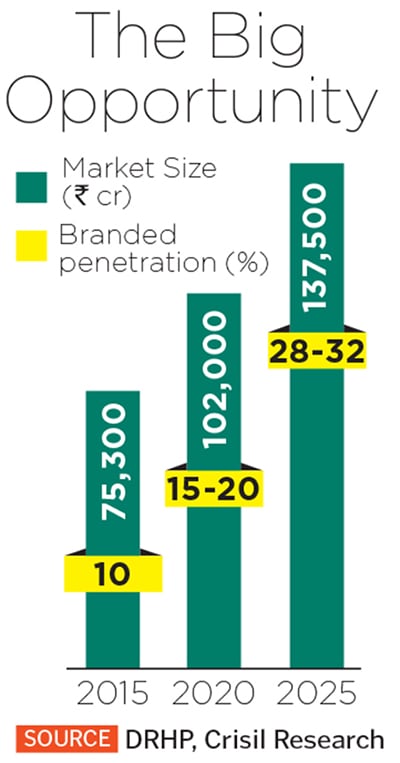 That meant, by the time he was 13, Modi joined his father at their retail store, which sold everything from shirts and pants to jeans, after school. “I found a lot of interest," says Modi. “Somehow, I didn’t realise that my entire childhood from 13 years went in my store." While he did contemplate doing an MBA after graduating in commerce from St Xavier’s college, Kolkata, his father suggested otherwise. “The real MBA happened in those nine years between 13 and 22," says Modi.
That meant, by the time he was 13, Modi joined his father at their retail store, which sold everything from shirts and pants to jeans, after school. “I found a lot of interest," says Modi. “Somehow, I didn’t realise that my entire childhood from 13 years went in my store." While he did contemplate doing an MBA after graduating in commerce from St Xavier’s college, Kolkata, his father suggested otherwise. “The real MBA happened in those nine years between 13 and 22," says Modi.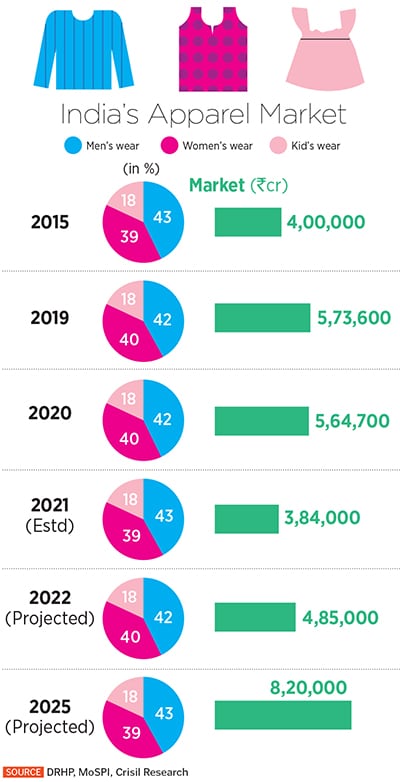 In 2006, to take care of his ailing father, Modi stepped away from work for some six months. “I used to work like a typical entrepreneur, managing everything. Life was very busy. Then I realised we were unnecessarily involving ourselves in operations. The business was running well without me for six months. From that day I understood, that instead of ROI (return on investment), it should be return on time invested (ROTI). I realised I should not waste time on things where I don’t add any value," he says.
In 2006, to take care of his ailing father, Modi stepped away from work for some six months. “I used to work like a typical entrepreneur, managing everything. Life was very busy. Then I realised we were unnecessarily involving ourselves in operations. The business was running well without me for six months. From that day I understood, that instead of ROI (return on investment), it should be return on time invested (ROTI). I realised I should not waste time on things where I don’t add any value," he says.
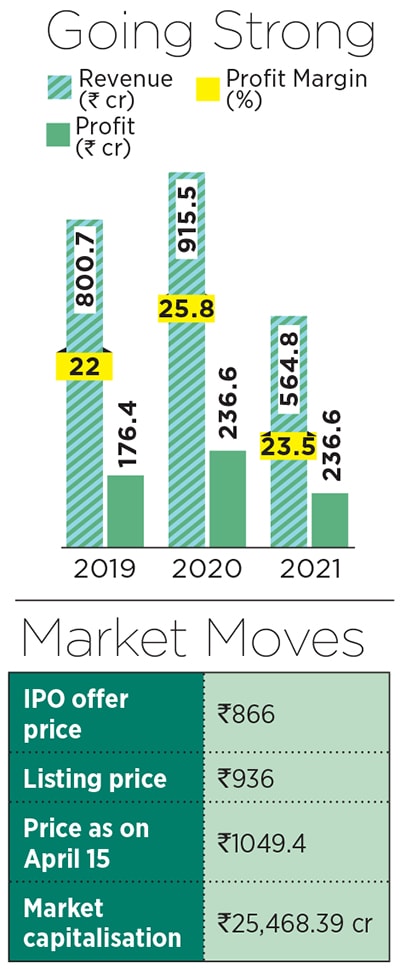 The company operates in 230 cities, and is busy firming up plans to open stores in 150 new cities. A significant portion of its customers are spread across Southern India, with Bengaluru and Hyderabad emerging as the two big centres. “We have a cluster approach where we believe in 50 or 60 markets, where we have numerous stores," Modi says. “This is just the beginning of a multi-decade growth opportunity for the category."
The company operates in 230 cities, and is busy firming up plans to open stores in 150 new cities. A significant portion of its customers are spread across Southern India, with Bengaluru and Hyderabad emerging as the two big centres. “We have a cluster approach where we believe in 50 or 60 markets, where we have numerous stores," Modi says. “This is just the beginning of a multi-decade growth opportunity for the category."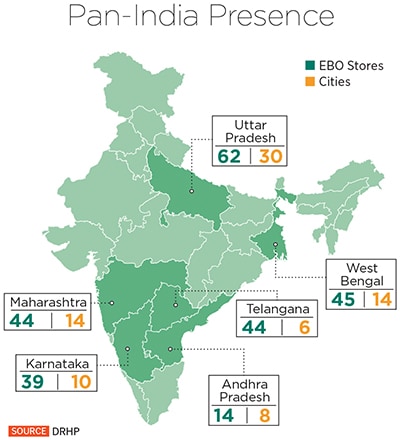 Today, 90 percent of the company’s business comes from EBO with about 8 percent from online models, a segment that Modi’s son, Vedant, and his team are extensively looking to build. “We might be the only brand with such a high percentage from EBOs," Modi says. “The segment is unorganised, fragmented, and understanding this is a journey. Because we were data-focussed, we could work it out." Along the way, Modi says his biggest advantage has been in reducing the inconvenience of wedding purchases.
Today, 90 percent of the company’s business comes from EBO with about 8 percent from online models, a segment that Modi’s son, Vedant, and his team are extensively looking to build. “We might be the only brand with such a high percentage from EBOs," Modi says. “The segment is unorganised, fragmented, and understanding this is a journey. Because we were data-focussed, we could work it out." Along the way, Modi says his biggest advantage has been in reducing the inconvenience of wedding purchases.
